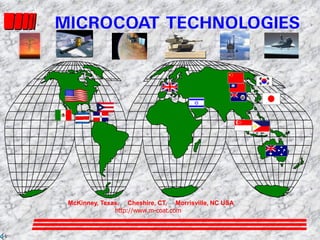
Thermal Management And Sd0802 C Presentation
- 1. McKinney, Texas McKinney, Texas, Cheshire, CT, Morrisville, NC USA http://www.m-coat.com MicroCoat Technologies
- 2. 3D-IC stacking is a promising technique for miniaturization and performance enhancement of electronic systems The adoption of advanced packaging technologies could change the industry food chain of the semiconductor. • Today wire bonding is limited in density and performances and Flip Chip cannot be used for chip stacking. 3D Stacked Die with Thermal Interconnects technology seems to be unavoidable in the future for miniaturization first, and increased performance and cost later. MicroCoat Technologies
- 4. Thermal Interposers *Photo Courtesy of Vertical Circuits, Inc. MicroCoat Technologies
- 5. Replaces ----- Thousands of Wire Bonds ! ! ! MicroCoat Technologies
- 6. Semiconductor packaging houses gain from more device complexity Increased I/O density on chips, power/performance requirements, yield/cost requirements and form factor constraints (mobile) are coming to push increased use of 3D technology. This trend benefits the packaging subcontractors in the semiconductor industry. Larger packaging subcontractors, like Amkor (AMKR), ASE, and SPIL, will take market share from smaller sub-contractors. Large packaging houses like Amkor have invested in 3D packaging technologies, such as through silicon via (TSV) fabrication, silicon interposers, etc. They are also well-positioned for an industry shift occurring from wire bonding to 3D. MicroCoat Technologies
- 7. Why Conductive Adhesive Edge Attach Interconnection? These novel interconnect systems interconnects provide solutions to many limitations of current SiP and Chip Stacking methods. Wire Bonding; Long Connections Low Density RC Delays High Impedance High Power consumption Poor Heat Dissipation Large Area Challenging Interposers I/O Pitch limitations Conductive Interposer; Short Connections Very High Density No RC Delays Low Impedance Low Power Consumption Excellent Heat Dissipation Small Connecting Area No Real I/O Limitations MicroCoat Technologies
- 8. MicroCoat Technologies High Thermally Conductive and Non- Conductive Adhesives Meet the Challenge for 3D Stacking for; Cell Phones, Smart Phones, PDAs, Digital Cameras, Wireless Networking, Game Boxes, Multimedia, etc. MicroCoat Technologies
- 9. Thermal Management of 3D Stacked Die Using Conductive Adhesive for Heat Dissipation The conductive paths provide an ground-breaking method for helping to cool the device(s) with the high thermal conductivity of the epoxy acting as cooling fins. It is shown that a 32MB 3D stacked DRAM cache can reduce the cycles per memory access of a twothreaded RMS benchmark on average by 13% and as much as 55% while increasing the peak temperature by a negligible 0.08ºC. Off-die BW and power are also reduced by 66% on average. It is also shown that a 3D floorplan of a high performance microprocessor can simultaneously reduce power 15% and increase performance 15% with a small 14ºC increase in peak temperature. Voltage scaling can reach neutral thermals with a simultaneous 34% power reduction and 8% performance improvement. Bryan Black, et al, Intel Corporation. MicroCoat Technologies
- 10. MCT SD0802C TC = >12.0 W/mK MCT 3417 Adhesive TC= >3.0 MicroCoat Technologies
- 11. 3D Thermal Management Using just “any” conductive adhesive will reduce your opportunity for success. 3-dimensional integrated circuits (3D IC’s) technology places circuit blocks in the vertical dimension in addition to the conventional horizontal plane. Compared to conventional planar ICs, 3D ICs have shorter latencies as well as lower power consumption, due to shorter wires. The benefits of 3D ICs increase as we stack more die, due to successive reductions in wire lengths. However, as we stack more die, the power density increases due to increasing proximity of active (heat generating) devices, thus causing the temperatures to increase. Also, the topmost die on the 3D stack are located further from the heat sink and experience a longer heat dissipation path. Kiran Puttaswamy Georgia Institute of Technology School of Electrical and Computer Engineering Atlanta, GA & Gabriel H. Loh Georgia Institute of Technology College of Computing Atlanta, GA MicroCoat Technologies
- 12. Advantages of SD0802C Over Other 3D Dispensable Adhesives Copper Bearing Standard Ag SD0802HTC REAL Interfacial Thermal Conductivity W/mK 4-7 2.5 – 4.2 12.0 Weight Loss on Cure TGA 4% 2.75 – 3.1% .07 - 1.1% Work Life (Hours) 12 12-48 144 !! MicroCoat Technologies
- 13. Advantages of SD0802C Over Other 3D Dispensable Adhesives Copper material shrinks more on cure that is why it cracks!! User will have long term failures trying to adhere to either aluminum or gold IC pads User will be able to use full 10cc syringes (40 grams) using SD0802 on JetSpray or Standard Dispense Equipment If a company is depositing a 200um line and it shrinks 4% that is 8um of shrinkage. The actual contact resistance between the dispensed copper material and the pad on the die will be very high and the adhesion will get progressively worse with temperature cycling SD0802 has a Cure Temperature Window of 80oC to >150oC MicroCoat Technologies
- 14. ** Thermal Conductivity vs. thermal impedance in adhesive bondlines. . Although some adhesive manufacturers may claim to have bulk thermal conductivity values higher than 30 W/m°K, device manufacturers need to appreciate that the bulk value is only an indicator of potential for heat transfer through the adhesive bondline. The material with the lowest thermal impedance should actually be the goal, as it is with this that the best heat transfer can actually be obtained. The factors that affect thermal impedance include: adhesion at the interface, surface wetting, thin adhesive bondlines, low shrinkage, and void-free bondlines. If the interfacial adhesion is weak or impacted by filler alignment or solvent removal, then the thermal resistance across the interface will be so great that the bulk resistivity becomes meaningless. If the bondline can be kept thin, for example by using a solventless adhesive, then heat transfer will be very efficient regardless of the difference in the bulk thermal conductivity. MicroCoat Technologies